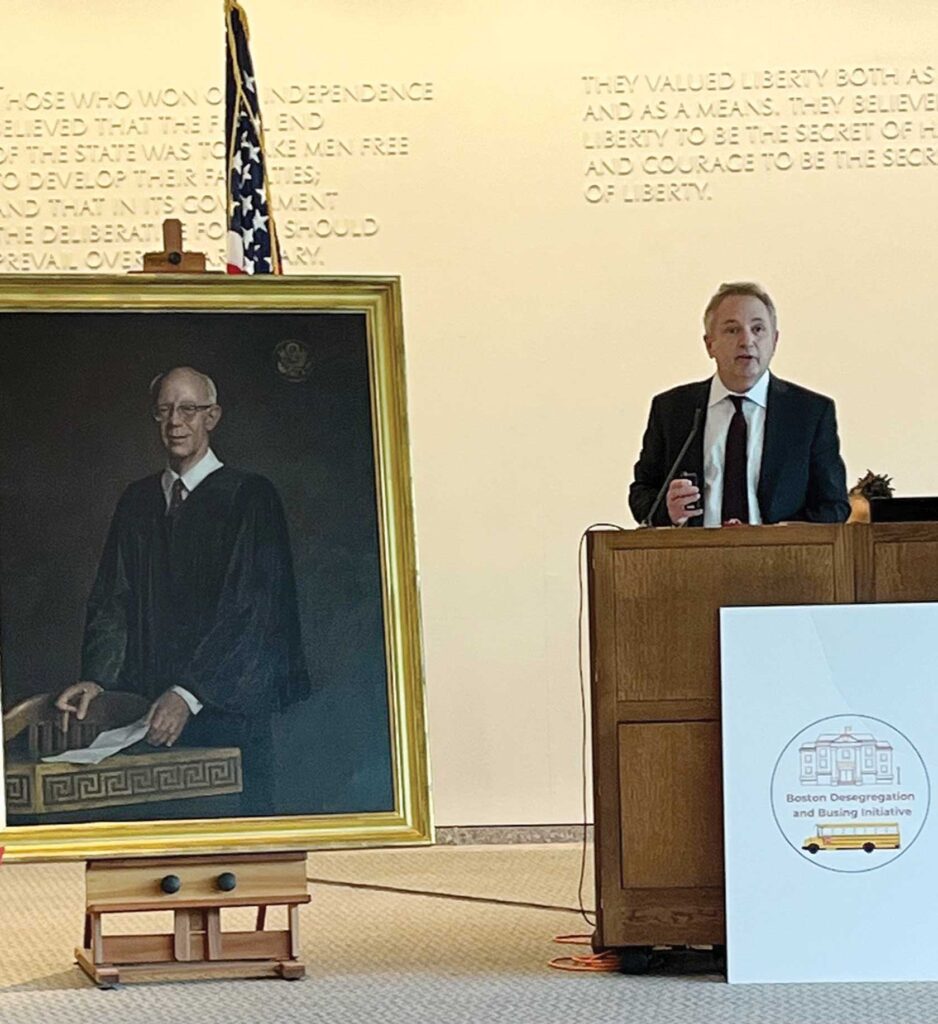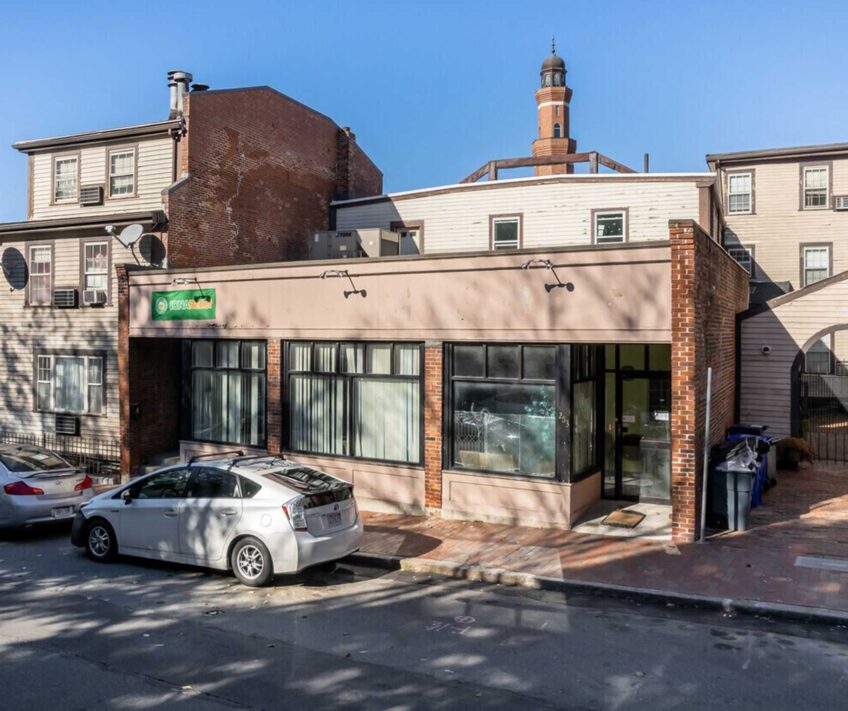After 50 years, Judge Garrity’s orders in Boston school case still defended

Federal judge W. Arthur Garrity, hailed as a hero or denounced as a villain, had no choice but to order the desegregation of Boston’s public schools in 1974 and deploy yellow buses to remedy a wanton violation of the Constitution, legal analysts involved with the epic case say.
The analysts included three lawyers who represented Black or Hispanic parents, two of Garrity’s law clerks and the state official who drafted the initial desegregation plan. Some panelists conceded the federal intervention had fallen short of its goals of racially balanced schools and equal educational opportunity for all students.
The nine panelists spoke at a forum at the Moakley Courthouse in the Seaport held the day before the 50th anniversary of Garrity’s order on June 21, 1974, in Morgan v. Hennigan. Alan D. Rose, who was Garrity’s only law clerk during the 1973 trial, said the evidence of deliberate segregation of Black students was overwhelming, leaving the judge no choice but to order a remedy. Rose cited the “selective use of busing” to keep Black and white students apart, rigged “feeder patterns” between schools with different grade levels, minutes of Boston School Committee meetings and a racist rant a former member sent to Garrity.
“We’re sometimes asked if there’s a smoking gun,” said Eric Van Loon, one of two lawyers who argued the case for the NAACP and Black parents. “There’s an arsenal.”
Loon and the lawyer who worked with him, Robert Pressman, noted that Garrity’s first step was simply to require the Boston School Committee, whose majority then was comprised of elected members who made racist appeals, to implement a state plan that the Massachusetts Supreme Judicial Court had already ordered the committee to adopt.
“Prior to any federal court order, it had been ordered into effect by our state supreme court,” Van Loon said. That plan for the first year was focused on racial balance in schools to comply with a state law, the Racial Imbalance Act, that the School Committee had repeatedly defied.
Charles Glenn, the desegregation plan’s primary author, said the Boston School Committee prohibited district officials from cooperating with state officials drafting the document, a step necessary because the School Department had refused to create its own.
“We could have devised a much better plan in many details if we had been provided up-to-date information about facilities and other planning considerations,” he said in his prepared remarks.
Glenn also said he had recommended, apparently anticipating the turmoil that ensued, that South Boston High School be left out of the initial plan. But he said a court precedent from the desegregation of Little Rock, Arkansas schools did not allow shaping a legal remedy based on fears of an adverse public reaction.
Terry Seligmann, Garrity’s law clerk in 1974-1975, said putting students on school buses had been unavoidable.
“There wasn’t a desegregation plan for Boston that didn’t involve busing,” she said.
Pressman pointed to a unanimous U.S. Supreme Court decision in a 1971 case concerning the desegregation of schools in and around Charlotte, North Carolina, that called busing “a normal and accepted tool of educational policy.”
Seligmann worked with Garrity during the development of a second-phase plan geared to promoting equal educational opportunity — the core demand of Black parents. That plan, first implemented in 1975, ordered greater diversity of teachers and administrators to shape curriculum and check “further discrimination within the schools,” the creation of specialized magnet schools, collaboration between universities or businesses and schools, and the establishment of parent councils with racial and ethnic diversity, she said. Around that time, independent research identified parental involvement as a factor in student achievement.
Also in 1975, Caroline Playter became involved with the case representing Hispanic parents in El Comité de Padres Pro Defensa de la Educación Bilingüe (Parents Committee for the Defense of Bilingual Education). She successfully argued for the educational effectiveness of transitional bilingual education, the inclusion of Hispanic students in the exam schools, a two-way bilingual school at the Hernandez School in the South End and the recruitment of Hispanic teachers.
“Unfortunately, so much has changed since then with the ascendance, in today’s terminology, of white nationalist (English only) and anti-immigrant politics and policies,” Playter said in her prepared remarks. “It has been and is dismaying and angering to have watched the dismantling of so much of the progress attained through the intervention of El Comité de Padres.”
A 2002 referendum banned bilingual education statewide in most cases. The state legislature lifted the ban in 2017 but bilingual education has not been fully restored.
Other panelists acknowledged Garrity’s orders, over the long haul, had fallen short of desegregation and equal educational opportunity for all of the city’s students.
Seligmann conceded the judge’s orders contributed to white flight from Boston Public Schools, undermining the effort to achieve racial balance. In 1974, 20% of Boston Public School students were Black and 10% were Hispanic or others of color. Today the district is 43% Hispanic, 29% Black and 15% white.
The school system was declared desegregated in 1987 but busing has continued to provide students with school options. Iván Madrigal-Espinoza, director of Lawyers for Civil Rights, noted that one of Garrity’s orders — mandating minimum percentages of Black and Hispanic teachers — is still in effect but unfulfilled. Under that 1985 order, 25% were to be Black and 10% were to be Hispanic or Asian.
Madrigal-Espinoza termed the overall desegregation effort “incomplete but perfect” under the law.
Jim Vrabel, a Boston historian, described the virtues of neighborhood schools as promoting parental involvement and a sense of community. But the city’s low-performing public schools are concentrated in mostly Black and Hispanic areas.
“I don’t know why we don’t have good schools in every neighborhood,” Vrabel said.
Martha Minnow, who as a graduate student evaluated the second year of Garrity’s order and later became dean of Harvard Law School, offered her evaluation of the entire case.
“Morgan v. Hennigan was a flawed but worthy effort,” she said. “Now, it falls to all of us to pursue the commitment to educational opportunity for all.”
The panel discussion was moderated by Tanisha Sullivan, president of the Boston Branch of the NAACP. About 120 people gathered in and near the courthouse’s jury assembly room, while more than that number, at least 147, tuned into the livestream.
Lawyers who represented the Boston School Committee in the desegregation case did not participate. That defense team was drawn from the local law firm Hale and Dorr, now called Wilmer Hale.
Lew Finfer, co-chair of the Boston Desegregation and Busing Initiative, which sponsored the forum, the second in a series, said the organization planned to invite members of that team but two surviving lawyers did not respond to messages.
The lead lawyer for the School Committee, James St. Clair, died in 2001. Two panelists noted he was considered the country’s leading trial lawyer in the early 1970s, so much so that when President Richard Nixon needed legal help during the Watergate scandal, he brought in St. Clair as his chief legal counsel.






